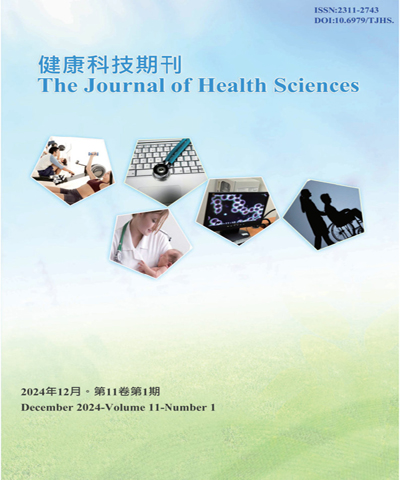
健康科技期刊/The Journal of Health Sciences
國立臺北護理健康大學,正常發行
選擇卷期
- 期刊
Objective: To investigate student learning outcomes when augmented reality (AR)- based digital learning materials are used to build skills in dysphagia care, with the overarching goal of improving the professional competence of part-time nursing students. Methods: This study employed a two-group, pretest-posttest experimental design. The interventional group comprised a class of 126 part-time nursing students; the control group comprised a class of 71 students in the same educational program and grade level. For the innovative teaching course, a new electronic textbook incorporating AR constituted the primary course material; the course materials were rendered into a handy, portable pocket manual for the part-time class serving as the control group, to facilitate comparison with the innovative teaching setting. Results: At the end of the course, students completed a self-evaluation using a Likert scale ranging from 1 to 5 points, with an average score of 4.50 points (standard deviation (SD) = 0.62). Student satisfaction with faculty instruction rated an average score of 4.85 points (SD = 0.36). Course satisfaction rated an average of 4.79 points (SD = 0.44). Paired t test analysis of the dysphagia care knowledge assessment results found a statistically significant improvement on Items 4 and 5 as well as on the overall score: t = -4.137 (P<.000), t = -2.161 (P<.033), and t = -2.573 (P<.012), respectively. Furthermore, independent t-test analysis of the two groups' posttest questionnaires revealed a significant difference on Items 2 through 5 (p = 0.000-0.041). Also, a survey concerning attitudes toward clinical dysphagia care yielded an average score of 2.40 points, which suggests that the majority of nursing students hold positive attitudes toward caring for dysphagia patients and collaborating with the health care team. Conclusions: The findings indicate that nursing students who received a multimedia-based electronic textbook that incorporates AR performed better on assessments of professional knowledge regarding dysphagia care than those who received only a hard copy of the instructional manual. In addition, the students also became more proactive in caring for dysphagia patients and collaborating with the health care team as a result of building professional competence in dysphagia care. Therefore, innovative multimedia-based educational materials could improve nursing students' learning efficiency and professional nursing skills.
- 期刊
目的:由於醫療與資訊科技發展,各醫療機構亦積極引進相關智慧產品,以提升臨床作業便利性。智慧藥櫃(Automated Dispensing Cabinet, ADC)導入顛覆傳統取藥操作模式,而護理端是ADC使用最頻繁之操作者,因此,此研究藉由分析護理師使用ADC之滿意度調查及給藥異常發生率,以作為往後引進相關智慧醫療使用之建議分享。方法:本研究為橫斷式研究,以SPSS 22.0統計軟體,進行描述性統計、以百分比、平均數、標準差、單因子變異數分析,分析護理師使用智慧藥櫃滿意度及智慧藥櫃介入前後給藥異常發生率。結果:共發出321份問卷,回收94.7%完整問卷。不同專科屬性之加護單位,ADC介入後其使用滿意度提升,且均呈顯著差異(p<.05),實施後整體滿意度4.31分大於實施前3.58分(t=13.469 , p=0.000)。智慧藥櫃介入後,給藥異常發生率自0.107% 降至0.091%。結論:此ADC設備為本院初次引進,並於疾病複雜度高的加護病房使用,不但獲得同仁正向之肯定,並助益給藥異常事件之改善,其成效可作為後續相關智慧醫療設備規劃推動之參考。
- 期刊
背景:可信賴的專業活動(EPAs)被認為是專業工作中不可缺少的常規業務。EPAs是臨床監督者依學員勝任能力,逐步授權進行臨床工作,是基於臨床能力表現所呈現的結果。目的:為新進護理人員的培訓,發展一套可信賴專業活動(EPAs)並檢定信效度。方法:採描述性研究設計,研究團隊以名義團體法和問卷調查,進行可信賴專業活動(EPAs)發展。透過120位護理專家完成EPAs主題確認及建構EPA內容,邀請EPAs專家以EPAs品質評量工具EQual(Queen's EPA Quality Rubric, EQual),評估EPAs結構及品質。再以評分者間一致性檢測其信度。結果:護理臨床專家按重要、常見、危險性,選定培訓期新進護理師的可信賴專業活動共8項。內容效度以EQual評量工具評分皆達4.07分以上。共12位臨床教師參與評分者訓練,評分者間的一致性:6項EPAs達≥ 0.80,達一致性可靠;2項EPAs為0.80 > α ≥ 0.66,一致性尚可接受。結論:建構培訓期新進護理師的可信賴專業活動(EPAs)內容,呈現良好的內容效度及評分者間信度。未來將全面推廣至臨床應用,以進一步驗證其可行性及適用性。
- 期刊
目的:本研究發展以情境為基礎之嬰幼兒健康照護線上課程並評值其成效。方法:研究為期一年分兩階段,第一階段以行動研究法進行數位教材發展,第二階段為課程介入實施及成效評量,研究設計採單組前後測,類實驗法。對象為北部某大學護理系二技學生(N= 47)。課程介入方法採混成線上學習,學生課前以非同步線上檢視案例影片媒材,並以google表單了解學習者的先備知識,課堂內以即時反饋系統(Kahoot!)進行形成性評量;再透過小組同儕間的討論情境案例等策略形成議題、統整知識。課程結果成效評量方法是以學習成效量表前後測,及質性資料。結果:學習成效評量整體平均分數由3.91(SD=0.63)提升至4.46(SD=1.01)並有統計顯著(p值<.05)。幼兒健康照護認知測驗後測平均成績雖優於前測,但未達統計顯著差異(p =.06)。質性資料分析學生表示彈性多元的混成學習環境有助學習。結論:本研究發展出適用於大學生護理課程的混成學習方式,結果可提供給護理教師作為未來在線上混成學習課程設計之參考。
- 期刊
目的:為能有效減少醫學中心護理人員針扎事件,分析某醫學中心2019年護理人員針扎案例共61件,原因為:針具操作行為不正確、對針扎防治之認知不足、人員對針扎防治行為不重視,不覺得重要、缺少針扎防治實務操作訓練、新進人員無稽核機制及病人無預警晃動肢體。方法:專案小組成員透過針扎預防策略:擬訂安全文化-針扎防治創意海報設計競賽活動、規劃針扎防治擬真教育訓練、及研擬新進人員定期稽核機制,結果:顯示護理人員針扎件數由61件下降至40件,不僅達成目標值,結論:顯示落實查核針扎防治行為、營造安全文化環境及推動擬真訓練,能有效降低護理人員針扎事件,進而提升護理人員職場環境安全。

